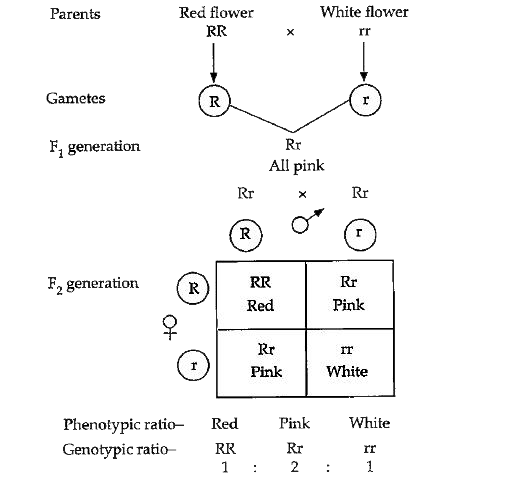Read the passage given below, and answer the questions that follow:
Some students wanted to investigate the pattern of inheritance of flower colour in snapdragon. They selected some plants which were homozygous for red flowers and some other plants which were homozygous for white flowers. These plants were labelled as Parental Plants (P1). These plants (red-flowered and white flowered), were cross-pollinated. The seeds obtained from these plants were planted in a separate field. These seeds germinated to produce the plants which were labelled as the plants of F1-generation.
Based on the above experiment, answer the following questions:
If the plants of F1-generation are allowed to self-pollinate, then in F2-generation.
All of the resulting plants will have pink flowers.
75% plants will have red flowers and the remaining 25% plants will have white flowers.
25% plants will have red flowers, 25% plants will have pink flowers and 25% will have white flowers.
25% plants will have red flowers and the remaining 75% plants will have white flowers.
Following cross will be made for the given experiment:

Monohybrid cross in snapdragon, where one allele is incompletely dominant over the other allele
25% will have red flowers, 50% will have pink flowers and 25% will have white flowers
Topper's Solved these Questions
- BOOK - ICSECHAPTER - SEXUAL REPRODUCTION IN FLOWERING PLANTS EXERCISE - COMPETITION CORNER ( OBJECTIVE TYPE QUESTIONS (ASSERTION AND REASON TYPE QUESTIONS ( FOR AIIMS ASPIRANTS )))16videos
SEXUAL REPRODUCTION IN FLOWERING PLANTS
- BOOK - ICSECHAPTER - SPECIMEN QUESTION PAPER (BIOLOGY)EXERCISE - QUESTIONS70videos
SPECIMEN QUESTION PAPER (BIOLOGY)
Similar Questions
Knowledge Check
- Question 1 - Select One
Read the passage given below, and answer the questions that follow:
Some students wanted to investigate the pattern of inheritance of flower colour in snapdragon. They selected some plants which were homozygous for red flowers and some other plants which were homozygous for white flowers. These plants were labelled as Parental Plants (P1). These plants (red-flowered and white flowered), were cross-pollinated. The seeds obtained from these plants were planted in a separate field. These seeds germinated to produce the plants which were labelled as the plants of F1-generation.
Based on the above experiment, answer the following questions:
The biological name of snapdragon is:AAntirrhinum majusBPisum sativumCLathyrus odoratusDRhizobium leguminosarum - Question 2 - Select One
Read the passage given below, and answer the questions that follow:
Some students wanted to investigate the pattern of inheritance of flower colour in snapdragon. They selected some plants which were homozygous for red flowers and some other plants which were homozygous for white flowers. These plants were labelled as Parental Plants (P1). These plants (red-flowered and white flowered), were cross-pollinated. The seeds obtained from these plants were planted in a separate field. These seeds germinated to produce the plants which were labelled as the plants of F1-generation.
Based on the above experiment, answer the following questions:
This type of inheritance can be described as:APolygenic inheritanceBIncomplete dominanceCCo-dominanceDPleiotropism - Question 3 - Select One
Read the passage given below, and answer the questions that follow:
Some students wanted to investigate the pattern of inheritance of flower colour in snapdragon. They selected some plants which were homozygous for red flowers and some other plants which were homozygous for white flowers. These plants were labelled as Parental Plants (P1). These plants (red-flowered and white flowered), were cross-pollinated. The seeds obtained from these plants were planted in a separate field. These seeds germinated to produce the plants which were labelled as the plants of F1-generation.
Based on the above experiment, answer the following questions:
The genotypic ratio of the plants of F2-generation will be:A1:2:3B9:3:3:1C1:2:1D3:1
Read the passage given below, and answer the questions that follow:
Some students wanted to investigate the pattern of inheritance of flower colour in snapdragon. They selected some plants which were homozygous for red flowers and some other plants which were homozygous for white flowers. These plants were labelled as Parental Plants (P1). These plants (red-flowered and white flowered), were cross-pollinated. The seeds obtained from these plants were planted in a separate field. These seeds germinated to produce the plants which were labelled as the plants of F1-generation.
Based on the above experiment, answer the following questions:
Select the statement which correctly predicts the phenotype of the plants of F1 generation.View SolutionIf a homozygous red flowered plant is crossed with a homozygous white flowered plant, the offspring would be
View SolutionPure red flowered and white flowered plants were crossed. It produced 120 offspring with
View SolutionHybrid of pure red flowered and white flowered Pea is crossed to pure red flowered plant. The progeny shall be
View SolutionHybrid of pure red flowered and white flowered Pea is crossed to pure red flowered plant. The progeny shall be
View Solution

